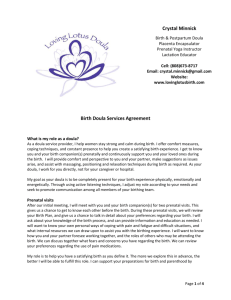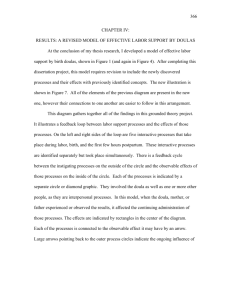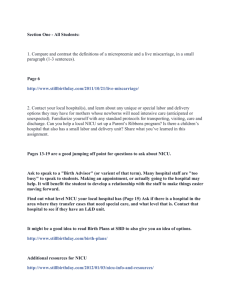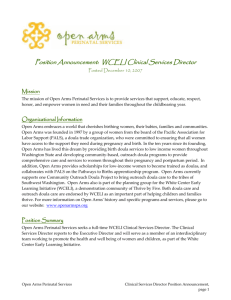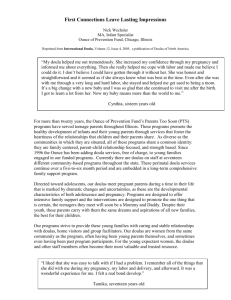Position Paper: The Birth Doula's Contribution to Modern Maternity
advertisement
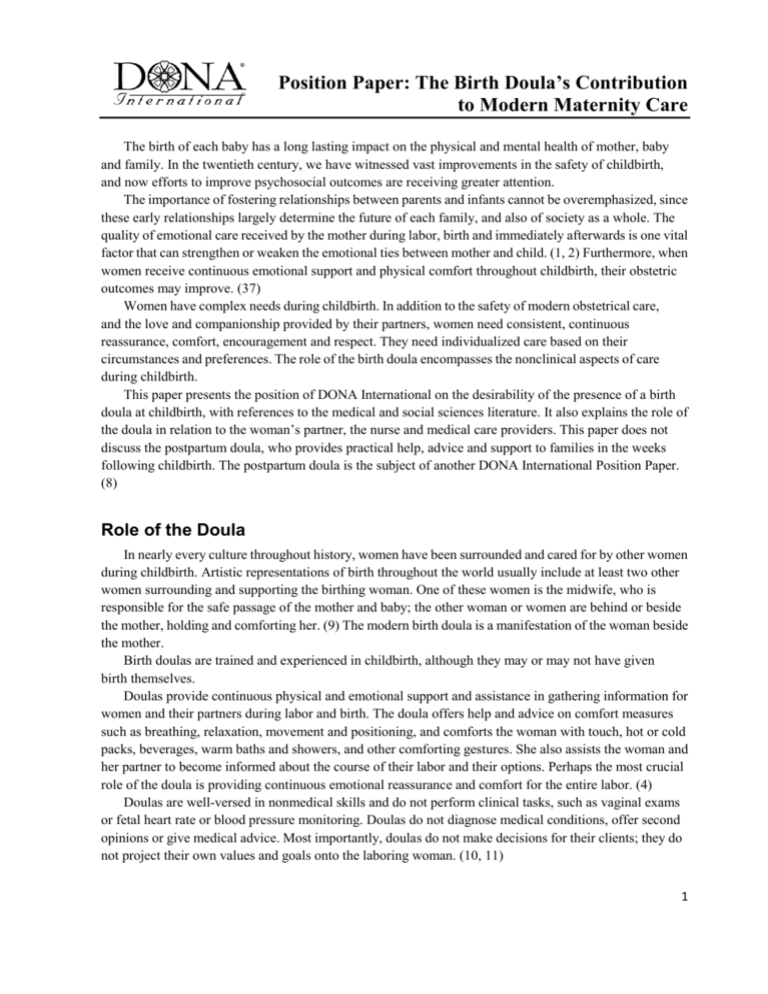
Position Paper: The Birth Doula’s Contribution to Modern Maternity Care The birth of each baby has a long lasting impact on the physical and mental health of mother, baby and family. In the twentieth century, we have witnessed vast improvements in the safety of childbirth, and now efforts to improve psychosocial outcomes are receiving greater attention. The importance of fostering relationships between parents and infants cannot be overemphasized, since these early relationships largely determine the future of each family, and also of society as a whole. The quality of emotional care received by the mother during labor, birth and immediately afterwards is one vital factor that can strengthen or weaken the emotional ties between mother and child. (1, 2) Furthermore, when women receive continuous emotional support and physical comfort throughout childbirth, their obstetric outcomes may improve. (37) Women have complex needs during childbirth. In addition to the safety of modern obstetrical care, and the love and companionship provided by their partners, women need consistent, continuous reassurance, comfort, encouragement and respect. They need individualized care based on their circumstances and preferences. The role of the birth doula encompasses the nonclinical aspects of care during childbirth. This paper presents the position of DONA International on the desirability of the presence of a birth doula at childbirth, with references to the medical and social sciences literature. It also explains the role of the doula in relation to the woman’s partner, the nurse and medical care providers. This paper does not discuss the postpartum doula, who provides practical help, advice and support to families in the weeks following childbirth. The postpartum doula is the subject of another DONA International Position Paper. (8) Role of the Doula In nearly every culture throughout history, women have been surrounded and cared for by other women during childbirth. Artistic representations of birth throughout the world usually include at least two other women surrounding and supporting the birthing woman. One of these women is the midwife, who is responsible for the safe passage of the mother and baby; the other woman or women are behind or beside the mother, holding and comforting her. (9) The modern birth doula is a manifestation of the woman beside the mother. Birth doulas are trained and experienced in childbirth, although they may or may not have given birth themselves. Doulas provide continuous physical and emotional support and assistance in gathering information for women and their partners during labor and birth. The doula offers help and advice on comfort measures such as breathing, relaxation, movement and positioning, and comforts the woman with touch, hot or cold packs, beverages, warm baths and showers, and other comforting gestures. She also assists the woman and her partner to become informed about the course of their labor and their options. Perhaps the most crucial role of the doula is providing continuous emotional reassurance and comfort for the entire labor. (4) Doulas are well-versed in nonmedical skills and do not perform clinical tasks, such as vaginal exams or fetal heart rate or blood pressure monitoring. Doulas do not diagnose medical conditions, offer second opinions or give medical advice. Most importantly, doulas do not make decisions for their clients; they do not project their own values and goals onto the laboring woman. (10, 11) 1 The doula’s goal is to help the woman have a safe and satisfying childbirth as the woman defines it. When a doula is present, some women have less need for pain medications, or may postpone them until later in labor; however, many women choose or need pharmacological pain relief. It is not the role of the doula to discourage the mother from her choices. The doula helps her to become informed about various options, including the risks, benefits and accompanying precautions or interventions for safety. Doulas can help maximize the benefits of pain medications while minimizing their undesirable side effects. The comfort and reassurance offered by the doula are beneficial regardless of the use of pain medications. The Doula and the Partner Work Together The woman’s partner (the baby’s father or another loved one) is essential in providing support for the woman. A doula cannot make some of the unique contributions that the partner makes, such as a longterm commitment, intimate knowledge of the woman and love for her and her child. The doula is there in addition to, not instead of, the partner. Ideally, the doula and the partner make the perfect support team for the woman, complementing each other’s strengths. In the 1960s, the earliest days of fathers’ involvement in childbirth, the expectation was that they would be intimately involved as advisors, coaches and decision-makers for women. This turned out to be an unrealistic expectation for most men because they had little prior knowledge of birth or medical procedures and little confidence or desire to ask questions of medical staff. In addition, some men felt helpless and distressed over the women’s pain and were not able to provide the constant reassurance and nurturing that women needed. With a doula present, the pressure on the partner is decreased and he or she can participate at his or her own comfort level. Partners often feel relieved when they can rely on a doula for help; they enjoy the experience more. For those partners who want to play an active support role, the doula assists and guides them in effective ways to help their loved ones in labor. Partners other than fathers (lovers, friends, family members) also appreciate the doula’s support, reassurance and assistance. Doulas as Members of the Maternity Care Team Each person involved in the care of the laboring woman contributes to her emotional wellbeing. However, doctors, nurses and midwives are primarily responsible for the health and wellbeing of the mother and baby. Medical care providers must assess the condition of the mother and fetus, diagnose and treat complications as they arise, and focus on a safe delivery of the baby. These priorities rightly take precedence over the nonmedical psychosocial needs of laboring women. The doula helps ensure that these nonmedical needs are met while enhancing communication and understanding between the woman or couple and the staff. Many doctors, midwives and nurses appreciate the extra attention given to their patients and the greater satisfaction expressed by women who were assisted by a doula. (12, 13, 14) Terms for labor support providers The terms describing labor support providers are sometimes confusing. When a person uses any of the terms below to describe herself, she may need to clarify what she means by the term. Doula – a Greek word meaning a woman who serves. In labor support terminology, doula refers to a specially trained birth companion (not a friend or loved one) who provides labor support. She performs no clinical tasks. Doula also refers to lay women who are trained and experienced in supporting families through postpartum adjustment. They are well-versed in emotional adjustment and physical recovery, 2 newborn development, care, and feeding. They also offer practical assistance with newborn care, household tasks and meal preparation. They promote parent confidence and parent-infant bonding through education, nonjudgmental support, and companionship. To distinguish between the two types of doulas, the terms birth doula and postpartum doula are used. See DONA International’s Position Paper, “The Postpartum Doula’s Role in Maternity Care.” (8) Labor Support Professional, Labor Support Specialist, Labor Companion – synonyms for birth doula. Birth Assistant, Midwife’s Assistant, Labor Assistant, Monitrice – sometimes these terms are used as synonyms for doula, but usually refer to lay women who are trained in limited clinical skills to assist a midwife (vaginal exams, blood pressure checks, set up for birth, fetal heart rate assessment, etc.) and who also provide some labor support. Research Findings In the late 1970s, when Drs. John Kennell and Marshall Klaus investigated ways to enhance maternal-infant bonding they found, almost accidentally, that introducing a doula into the labor room not only improved the bond between mother and infant, but also seemed to decrease the incidence of complications.(3, 4) Since their original studies, published in 1980 and 1986, numerous scientific trials have been conducted in many countries comparing usual care with usual care plus continuous labor support. In fact, the largest systematic review of continuous labor support, published in 2011, reported the combined findings from 21 randomized controlled trials, including over 15,000 women. (7) The trials compared “usual care” in the hospital with various types of providers of continuous labor support: a member of the hospital staff (i.e., a nurse); a family member or friend; and a doula (not a hospital employee, family member or friend) whose sole responsibility was to provide one-to-one supportive care. While overall, the supported women had better outcomes than the usual care groups, obstetric outcomes were most improved and intervention rates most dramatically lowered by doulas. According to a summary of the findings of this review (15), the doula-supported women were: • 28% less likely to have a cesarean section • 31% less likely to use synthetic oxytocin to speed up labor • 9% less likely to use any pain medication • 34% less likely to rate their childbirth experience negatively Obstetric outcomes were most improved and intervention rates most dramatically lowered by doulas in settings where: • the women were not allowed to have loved ones present • epidural analgesia was not routine (when compared to settings where epidurals are routine) • intermittent auscultation (listening to fetal heart rate) or intermittent (versus continuous) electronic fetal monitoring was allowed Services and costs There are two basic types of doula services: independent doula practices and hospital/agency doula programs. Independent doulas are employed directly by the parents. They meet prenatally one or more times and maintain contact by email or telephone. The doula becomes familiar with the woman’s and her partner’s preferences, concerns, and individual needs. Once labor begins, the doula arrives when the woman or her partner asks her to come, and stays with them until after the birth. One or more postpartum meetings are included in the doula’s service. Most doulas charge a flat fee, and some base their fees on a 3 sliding scale. Another type of doula service is the doula program associated with or administered by a hospital or community service agency. The doulas may be volunteers or paid employees of the hospital or agency. These programs vary widely in their design. In some, the hospital or agency contracts with an independent community-based doula group to provide the doulas. Others train and employ their own staff of doulas. Payment of the doula may come from the institution, the client or it may be shared by the two. Some hospital/agency services are set up as on-call doula services. A rotating call schedule ensures that there are doulas available at all times. They meet the client for the first time during labor and quickly establish a relationship. Other hospital or agency doula programs match a doula with each expectant mother, along with a backup doula. They work together in much the same way that private doulas and clients work together. Questions to Ask a Doula In selecting a doula, the following questions should help expectant parents make a good decision. These same questions might also be asked by maternity care professionals who wish to know more: • • • • • • • • • • What training have you had? (If a doula is certified, you might consider checking with the organization.) Tell me about your experience with birth, personally and as a doula. What is your philosophy about birth and supporting women and their partners through labor? May we meet to discuss our birth plans and the role you will play in supporting me through birth? May we call you with questions or concerns before and after the birth? When do you try to join women in labor? Do you come to our home or meet us at the hospital? Do you meet with us after the birth to review the labor and answer questions? Do you work with one or more back up doulas for times when you are not available? May we meet them? What are your fees and your refund policies? Third-party reimbursement of doula services Insurance companies in some countries are increasingly offering coverage for doula services, either as a listed service, through the clients’ flexible spending accounts, or as part of their universal health care coverage. Grant funding for doula services is also sometimes available, and, in the USA, some Medicaid-funded health agencies have contracts with doula organizations to support women in poverty and women with special needs. Although some health insurance and flex pay plans pay for doulas, at present, private doula care is usually paid for directly by the client. Training and Certification of Doulas Doula training focuses on the “art of labor support,” that is, the emotional needs of women in labor, and nonmedical physical and emotional comfort measures. The program requires that participants have some prior knowledge, training, and experience relating to childbirth, and consists of an intensive two to four day seminar, including communication skills, understanding of the psycho-emotional experience of childbearing, hands-on mastery of comfort and labor enhancing measures, such as relaxation, breathing, 4 positioning and movements to reduce pain and enhance labor progress, touch, and many others. To become certified by DONA International, the doula meets the following requirements: • • either a background of work and education in the maternity field, or observation of a series of childbirth classes; either a background of work and education in the lactation field, or attendance at a professional level breastfeeding course lasting a minimum of three hours; agreement to adhere to DONA International’s Standards of Practice and Code of Ethics; • attendance at a doula skills workshop offered by a DONA Approved Birth Doula Trainer; • • • • completion of extensive background reading from a list of recommended books and published articles; submission of an essay that demonstrates understanding of the integral concepts of labor support; receipt of positive evaluations from clients, doctors or midwives, and nurses; submission of detailed records, observations and essays from a minimum of three births; • development of a client resource list with a minimum number of entries in specific categories; • continuing membership in DONA International • Summary and Conclusion In summary, doulas provide unique positive contributions to the care of women in labor. By attending to women’s emotional needs, some obstetric outcomes are improved. Just as importantly, early mother-infant relationships and breastfeeding are enhanced. Women’s satisfaction with their birth experiences and even their self-esteem appears to improve when a doula has assisted them through childbirth. Analysis of the numerous scientific trials of labor support led the prestigious scientific group, The Cochrane Collaboration’s Pregnancy and Childbirth Group in Oxford, England to state: “Continuous support during labor has clinically meaningful benefits for women and infants and no known harm.” (7) References 1. Klaus MH, Kennell JH, Klaus PH. “Longer-term benefits of doula support.” Chapter 6, in The Doula Book, 3rd Edition. Da Capo Press, A Division of Perseus Books Group, Boston, Mass. 2012. 2. Hodnett ED. Pain and women’s satisfaction with the experience of childbirth: a systematic review. Am J Obstet Gynecol 186 (5Supplement): S160172, 2002 3. Sosa R, Kennell JH, Klaus MH, Robertson S, Urrutia J. “The effect of a supportive companion on perinatal problems, length of labor, and motherinfant interaction,” N Engl J Med, 303:597600, 1980. 4. Klaus MH, Kennell JH, Robertson SS, Sosa R. “Effects of social support during parturition on maternal and infant morbidity,” Br Med J, 293:585587, 1986. 5. Kennell JH, Klaus MH, McGrath SK, Robertson S, Hinkley C. “Continuous emotional support during labor in a US hospital: a randomized controlled trial,” JAMA 265:21972201, 1991. 6. McGrath SK, Kennell JH. A randomized controlled trial of continuous labor support for middleclass couples: effect on cesarean delivery rates. Birth. 2008 Jun;35(2):927 7. Hodnett ED, Gates S, Hofmeyr GJ, Sakala C, Weston J . “Continuous support for women during childbirth.” Cochrane Database Syst Rev. 2011 Feb 16; (2):CD003766. 5 8. Kelleher J. Position Paper: The Postpartum Doula’s Role in Maternity Care. DONA Internationals, Denver. 2008 9. Ashford JI. George Engelmann and Primitive Birth. Janet Isaacs Ashford, Solana Beach, CA, 1988. 10. DONA International. Standards of Practice. DONA International, Aurora, CO, 2008. 11. DONA International. Code of Ethics. DONA International, Aurora, CO, 2008 12. Ballen LE, Fulcher AJ. “Nurses and doulas: Complementary roles to provide optimal maternity care”. JOGNN 35: 304311, 2006 13. Gilliland AL. “After praise and encouragement: Emotional support strategies used by birth doulas in the USA and Canada.” Midwifery 27: 525531, 2011. 14. Hodnett E, Lowe N, Hannah M, Willan A, Stevens B, Weston J et al. Effectiveness of nurses as providers of labor support in North American hospitals: a randomized controlled trial. JAMA 288:147481, 2002. 15. Childbirth Connection. “Best Evidence: Labor Support.” 2011. Retrieved on 3/17/2012 from http://www.childbirthconnection.org/article.asp?ck=10174&ClickedLink= 257&area=27 This paper was written by Penny Simkin and approved by the 2012 DONA International Board of Directors. For more information about doulas, contact: DONA International (888) 788-DONA (3662) info@DONA.org www.DONA.org © DONA 1998, 2005, 2006, 2012. Permission granted to freely reproduce in whole or in part with complete attribution. 6

